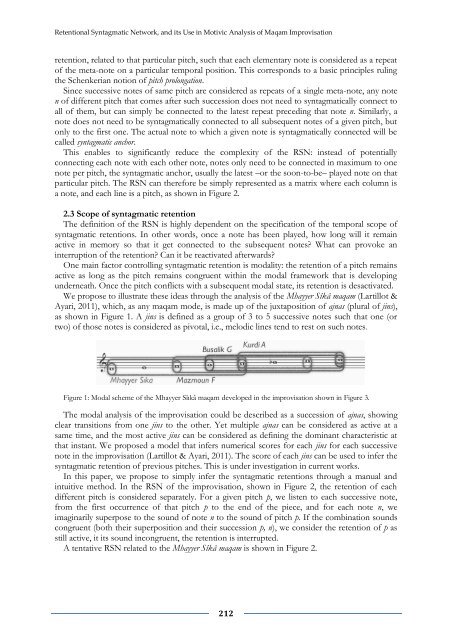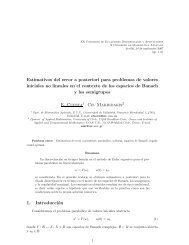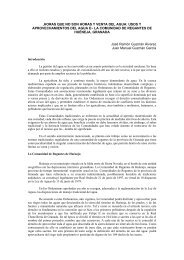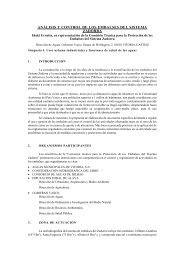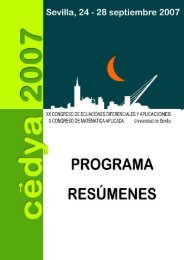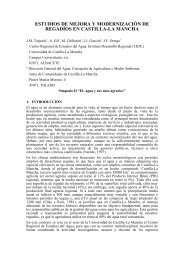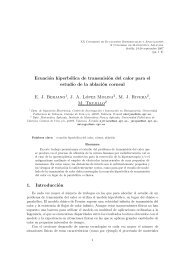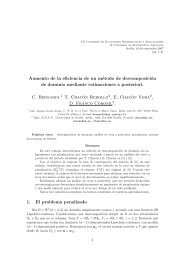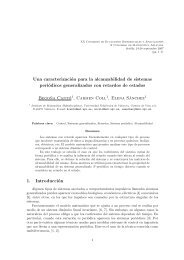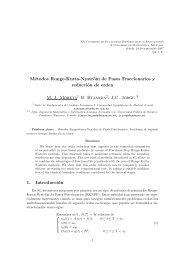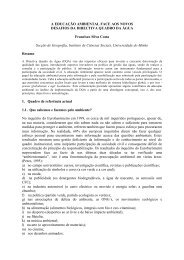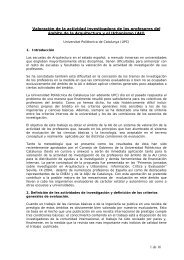LIBRO DE ACTAS (pdf) - Universidad de Sevilla
LIBRO DE ACTAS (pdf) - Universidad de Sevilla
LIBRO DE ACTAS (pdf) - Universidad de Sevilla
You also want an ePaper? Increase the reach of your titles
YUMPU automatically turns print PDFs into web optimized ePapers that Google loves.
Retentional Syntagmatic Network, and its Use in Motivic Analysis of Maqam Improvisation<br />
retention, related to that particular pitch, such that each elementary note is consi<strong>de</strong>red as a repeat<br />
of the meta-note on a particular temporal position. This corresponds to a basic principles ruling<br />
the Schenkerian notion of pitch prolongation.<br />
Since successive notes of same pitch are consi<strong>de</strong>red as repeats of a single meta-note, any note<br />
n of different pitch that comes after such succession does not need to syntagmatically connect to<br />
all of them, but can simply be connected to the latest repeat preceding that note n. Similarly, a<br />
note does not need to be syntagmatically connected to all subsequent notes of a given pitch, but<br />
only to the first one. The actual note to which a given note is syntagmatically connected will be<br />
called syntagmatic anchor.<br />
This enables to significantly reduce the complexity of the RSN: instead of potentially<br />
connecting each note with each other note, notes only need to be connected in maximum to one<br />
note per pitch, the syntagmatic anchor, usually the latest –or the soon-to-be– played note on that<br />
particular pitch. The RSN can therefore be simply represented as a matrix where each column is<br />
a note, and each line is a pitch, as shown in Figure 2.<br />
2.3 Scope of syntagmatic retention<br />
The <strong>de</strong>finition of the RSN is highly <strong>de</strong>pen<strong>de</strong>nt on the specification of the temporal scope of<br />
syntagmatic retentions. In other words, once a note has been played, how long will it remain<br />
active in memory so that it get connected to the subsequent notes? What can provoke an<br />
interruption of the retention? Can it be reactivated afterwards?<br />
One main factor controlling syntagmatic retention is modality: the retention of a pitch remains<br />
active as long as the pitch remains congruent within the modal framework that is <strong>de</strong>veloping<br />
un<strong>de</strong>rneath. Once the pitch conflicts with a subsequent modal state, its retention is <strong>de</strong>sactivated.<br />
We propose to illustrate these i<strong>de</strong>as through the analysis of the Mhayyer Sîkâ maqam (Lartillot &<br />
Ayari, 2011), which, as any maqam mo<strong>de</strong>, is ma<strong>de</strong> up of the juxtaposition of ajnas (plural of jins),<br />
as shown in Figure 1. A jins is <strong>de</strong>fined as a group of 3 to 5 successive notes such that one (or<br />
two) of those notes is consi<strong>de</strong>red as pivotal, i.e., melodic lines tend to rest on such notes.<br />
Figure 1: Modal scheme of the Mhayyer Sîıkâ maqam <strong>de</strong>veloped in the improvisation shown in Figure 3.<br />
The modal analysis of the improvisation could be <strong>de</strong>scribed as a succession of ajnas, showing<br />
clear transitions from one jins to the other. Yet multiple ajnas can be consi<strong>de</strong>red as active at a<br />
same time, and the most active jins can be consi<strong>de</strong>red as <strong>de</strong>fining the dominant characteristic at<br />
that instant. We proposed a mo<strong>de</strong>l that infers numerical scores for each jins for each successive<br />
note in the improvisation (Lartillot & Ayari, 2011). The score of each jins can be used to infer the<br />
syntagmatic retention of previous pitches. This is un<strong>de</strong>r investigation in current works.<br />
In this paper, we propose to simply infer the syntagmatic retentions through a manual and<br />
intuitive method. In the RSN of the improvisation, shown in Figure 2, the retention of each<br />
different pitch is consi<strong>de</strong>red separately. For a given pitch p, we listen to each successive note,<br />
from the first occurrence of that pitch p to the end of the piece, and for each note n, we<br />
imaginarily superpose to the sound of note n to the sound of pitch p. If the combination sounds<br />
congruent (both their superposition and their succession p, n), we consi<strong>de</strong>r the retention of p as<br />
still active, it its sound incongruent, the retention is interrupted.<br />
A tentative RSN related to the Mhayyer Sîkâ maqam is shown in Figure 2.<br />
212


